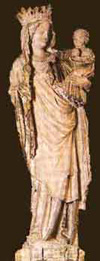Medieval Art in the Margins - Notre Dame, Paris

My earliest association with medieval art came when I walked through the door of the Romanesque church at Coutances and smelled the stone. Stone that has been a part of a church for centuries, a church with prayers, candles, incense, and the ritual gatherings of life has moist, silky, cool smell, a remembering kind of smell that is both evocative and seductive. I was seduced - and have been seduced in similar ways since then. Only recently has it occurred to me to begin to look at this seduction as an art historian.
Susan R. Dixon
NOTRE DAME, PARIS
Some time ago I found myself leaning against a massive stone pier in Notre Dame, Paris looking at the 14th century Madonna and Child at the head of the north aisle. I had been in France a month studying Romanesque art and it was my last night.The Madonna stood with an elegant swaying posture under a massive crown, surrounded by banks of flowers, bouquets of candles, and a steadily changing court of worshippers. Her drapery had bits of what at one time was vivid color now softened to a creamy satin, and the edges and surfaces of its deep folds caught and reflected the candlelight. Her gaze was on her dignified child sitting erect on her left arm but the slight turn of her head forward and down, particularly under the flickering light, gave the illusion of movement, as though she were looking in two places at once. Her expression - dignity tinged with disdain - made her seem simultaneously receptive and remote. I asked her for something. And I got it.
1, 2
© 2000 Ariadne's
Thread, Inc. Ithaca, N.Y.
MAIL TO: ariadne@ariadne.org